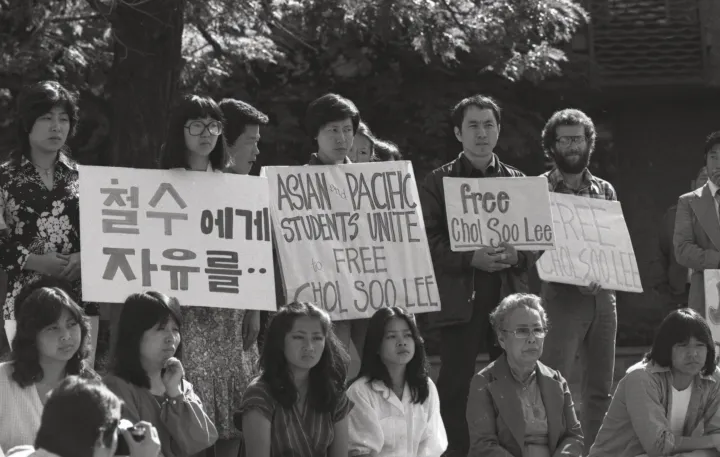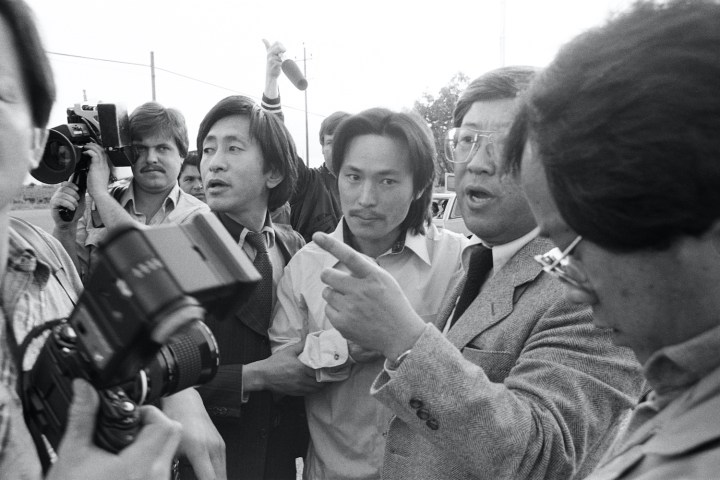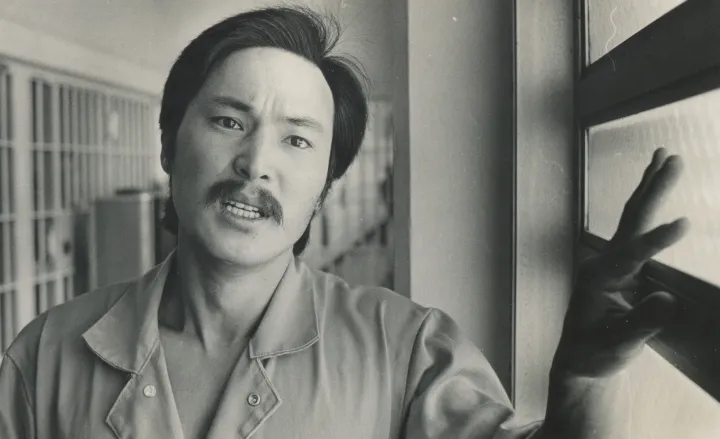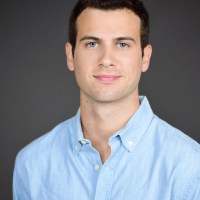In 1973, Chol Soo Lee, a young Korean immigrant, was arrested for the murder of Yip Yee Tak, a Chinese American man, in San Francisco’s Chinatown. Despite unreliable testimonies and a lack of evidence, Lee was wrongfully convicted of murder and sentenced to life in prison. That’s where the story begins in Free Chol Soo Lee, the latest documentary for PBS’s Independent Lens. After killing an inmate in prison a few short years later, an act he claimed was in self-defense, Lee faced the death penalty.
Shortly before the second murder conviction, a Korean American journalist named K.W. Lee began researching the case and discovered the botched police investigation could be attributed to racism, racial profiling, and stereotypes against Asian Americans. K.W.’s articles about the case inspired the Pan-Asian American social justice movement to free Chol Soo Lee from prison. The grassroots campaign eventually led to an acquittal, but the improbable victory was short-lived as Lee struggled with life as a hero in the Asian American community.
Directed by Julie Ha, the former editor-in-chief of KoreAm Journal, and Eugene Yi, a filmmaker/editor whose work has been in Berlinale and The New York Times, Free Chol Soo Lee depicts how one man’s wrongful conviction triggered a landmark movement in American. Ha and Yi spoke to Digital Trends about why the case has become a forgotten relic of this country’s past and how this documentary aims to reignite Lee’s legacy and keep his memory alive.

Note: This interview has been edited for length and clarity.
Digital Trends: This project has been years in the making, and now it’s finally going to be seen by the masses on PBS. How are you feeling? Is it relief or gratitude?
Julie Ha: Oh, gosh, it’s all of the above. We first released the film into the world in January 2022 at Sundance and felt very honored to be able to take the film to different parts of the country last year and even abroad to other countries. Having now this opportunity to show the film on PBS as Independent Lens and having this incredible reach through public TV, we feel really, really grateful and honored.
Chol Soo Lee’s story is not only an important legal case but a landmark moment in American history. In reading the comments from K.W. Lee and other people involved, they feel the case was forgotten and pushed to the side. K.W. mentioned that it was not taught in Asian-American studies classes at universities and colleges. Eugene, why do you think the case disappeared from the spotlight?
Eugene Yi: Well, Chol Soo himself spoke about this a bit. He wondered whether it was because his case wasn’t as clean as other better-known cases might be. We start the film with the idea that he was no angel on the outside. He was a kid who grew up by his wits, and he had a record. Once he was released, he struggled with addiction and institutionalization, compounding the trauma he’d already been through. He also had this desperate desire to live up to the hopes of the community. They made him a symbol, and he wanted desperately to pay back this incredible gift of freedom that they’d given him. But he struggled.
When Julie and I first started working on the film, we knew we couldn’t avoid any of that, of course. You can’t tell the story without that. They see his stumbles and his flaws, but they also see his strength, his resilience, his charisma, his fight, [and] his humanity. I think that [the audience] can connect with how he could inspire this movement.
This project can be traced to when Julie attended the funeral of Chol Soo Lee. Julie, can you describe your emotions from that day?
Ha: Back in 2014, Chol Soo passed away at age 62. I had actually attended the funeral to write an obituary for a magazine I was working for. Also, I was worried about K.W. Lee, the journalist in our film. He’s been my mentor for 30-plus years. He had become a father figure to Chol Soo and had never expected to outlive him. While at the funeral, I was struck by the emotion in the room, people expressing not just grief, but deep regret.
I saw many of the activists who had come to Chol Soo’s aid 40 years earlier. A couple of them were saying they regretted not doing enough for Chol Soo. That really took me back because I knew that this was a six-year-long movement to help free him from prison. They dedicated their lives to helping free this stranger. At one point, K.W. Lee stood up. He was clutching this Buddhist monk’s walking stick that Chol Soo had carved for him out of a tree. He was very emotional, and he said, “Why is this story underground after all these years?” This was a landmark Pan-Asian American social justice movement, really the first of its kind in our country, and yet as you said, it was not even taught in Asian American studies classes.
Fast forward nine months later, Eugene and I were talking about making a film together because we had previously collaborated as journalists for a Korean American magazine and really shared this passion for wanting to tell complex stories about our community with nuance and depth. I talked about the heaviness of the funeral, which had stayed with me all that time. He and I just knew that we needed to dig in. We needed to dig in and excavate this story before it became completely buried in history. We almost felt like it was actually our generational responsibility. I think we knew that this story, even though it’s 40 years old, could actually have deep resonance today.

In those initial conversations, what were some of the key elements that you knew had to be told in the story?
Yi: With stories like this, so much relies on the archive. With communities like ours, you just never know how much is out there because communities like ours are traditionally not included in the mainstream narratives. In the face of that exclusion and that marginalization, what’s even out there, in terms of material? That led to earlier parts of the journey to see what was out there because we didn’t know. But K.W. started introducing us to people, and it was incredible what folks not only had but were willing to share with us like. Sandra Gin, a television journalist at the time, made a documentary about the Chol Soo Lee case in 1983. She had material that had never been seen that she shared with us, which was incredible.
K.W. Lee had boxes and boxes and boxes of stuff. Included in there were hours of recordings of him and Chol Soo having these very intimate conversations. Over the course of that process, what we found was not only that there would be enough to make a film, but something more profound had happened. It’s almost like the community decided to create this archive. Each individual person had decided to do that. It’s notable again that it’s folks from the community, largely Asian-Americans, who had this material that they so just generously shared with us to create this archive. We’re just indebted to them. We wouldn’t have a film today if it wasn’t for what they did because they recognized this history. They saw that it was worth preserving.
You had this archive, and you’re getting all these materials. When did you decide to go with Sebastian [Yoon] to narrate and voice Chol Lee’s emotions and writings? Did that decision add another layer of pressure to the project?
Ha: I think that was actually a major decision, even to go with narration, period. I think we were trying so hard to allow Chol Soo Lee himself to find agency through our film that we wanted to use as much of his real voice as possible. But we found that it was just too difficult. We weren’t going to be able to capture so much of his internal journey and story if we didn’t use narration. He had left behind so many of his writings. We did use his memoirs as well as letters and also interviews and speeches that he gave to assemble the script for what he says in our film.
I would say, too, that Eugene and I felt this nagging insecurity for so many years after we scripted the lines for Chol Soo Lee because we never had a chance to interview him ourselves. We felt like as much as we were immersing ourselves in everything he left behind, maybe we weren’t getting close enough. Once Sebastian, our narrator, joined our film, it felt like everything fell into place. Sebastian’s a formerly incarcerated Korean-American. He was the discovery of our producer, Su Kim, who saw him speaking at a public event and was so moved by him and just instinctually felt he could voice Chol Soo Lee.
He was incredible. He not only did the narration, [but] he actually helped us revise the script. We wrote new scenes based on his input, especially about fleshing out the experience of incarceration and what that was like for Chol Soo Lee. One important thing Sebastian told us was that it wasn’t just prison violence that Chol Soo was confronting, but it was mental and internal anguish. The dehumanization that you experience every day, the depression, the isolation, the loneliness. Based on that input, we did script new scenes. Sebastian said he identified so strongly with Chol Soo’s experience. He read his memoir, too, and felt so connected to him.
With the narration in the film, you feel that lived experience that Sebastian brought from his own experience of incarceration and that connection that I think he felt with Chol Soo Lee. To be honest, I think Chol Soo Lee would have been really pleased to know that Sebastian voiced him for our film because Chol Soo had often talked about forming a foundation for formerly incarcerated APIs. I think knowing that his voice was brought to life by Sebastian would have made him very happy.
There are films about people who spend years in prison that end when they are exonerated and leave prison. In this documentary, that’s only half the story, as there was another layer to Chol Soo’s life outside prison. Were you always planning to cover his life outside of prison? Did you know about his struggle before making the documentary, or did that idea [to cover life outside of prison] come during the filmmaking process?
Yi: I guess a bit of both. We always knew that we had to tell this part of the story. There’s no way to tell the story without telling this full story of what happened once he was released and really examining what kind of relationship he had with the community, what we called in the edit his “surrogate family” of activists and people in the community who came forth. It’s also the reality of what happens when people are released from prison. That’s not where the story ends. To really shine a light on everything that he went through, that part was really important for us.
The part that came through in the edit was figuring out what parts of a story to tell. I don’t want to get into it too much because I hope that folks will watch the film. But I think that’s the part where working with the talented editors (Jean Tsien and Aldo Velasco) was really vital to crafting that part of the story to make it so that there is still a narrative for us to share with the audience.
Ha: I think it’s also worth mentioning that there was a previous documentary about the Chol Soo Lee case by Sandra Gin, a broadcast news journalist, in 1983. That documentary ended with his release from prison. We had always known that we needed to continue the story. It didn’t end there, and now we could look back more than 40 years with 20-20 hindsight, in some sense, and try to tell the full story. Sandra Gin, who was so helpful with our film and provided so much footage for us, said, “I feel like you guys are writing the epilogue.” She felt like she was passing the baton to us.
What is a takeaway you want people to have after seeing this film?
Yi: A couple of quick things. There was an unlikely solidarity at the core of this. Asian Americans weren’t expected to come together like this, as Chinese, Japanese, Korean, [and] Vietnamese. That was not what happened at that point. The idea of Asian America had just been invented, as a term, not long before the movement happened. There is something really crucial in that idea because people had to come together to overcome these barriers of language and class and politics and identity to work together.
It wasn’t easy. That’s one part that we don’t get into in the documentary. They really had to work at this. They came together and found a common cause and were able to free Chol Soo Lee. There’s something really powerful in that idea. They carved an idea of what Asian America could be: very political, active, and engaged with these issues.
On the one hand, of course, there is just the takeaway of wanting Asian Americans to be involved with these issues because these are issues as Americans and as human beings. Additionally, finding those unlikely solidarities around one and finding common cause in places where folks might not necessarily think to find it. There is just so much out there that needs addressing, [and] needs changing. We hope that the lesson that these activists provided is something that people can find inspiration from today.

Ha: I feel like we tell stories to change the world. We tell stories to help us feel more connected to each other as a common humanity. I like to encourage people to personalize the message of this film, [and] to open their hearts and minds to the story of Chol Soo Lee. Obviously, to feel his pain and struggle, but also his resilience. To take inspiration from this incredible movement of resistance that Eugene was talking about. They did the impossible. They overturned two murder convictions in our American criminal justice system, which many lawyers would tell you is impossible. But they did it at a time when Asian Americans had very little political power.
Sometimes, we can grow so cynical and have this feeling of hopelessness that the problems before us are too large to surmount and overcome. I think I know for myself personally when I look at what they did more than 40 years ago, I take tremendous inspiration from that. We hope people will allow this story to move and maybe change them. To change their views on how they look at our criminal justice system, [and] how they look at Asian-Americans. Maybe they’re not used to seeing Asian Americans in these roles and these contexts. Maybe, it’ll humanize members of our community for them.
We hope people will allow it to move them, to change them, and maybe ask themselves what are each of our roles in creating a more just society. So in that way, we hope that we are keeping the legacy of Chol Soo Lee alive and allowing him to speak and send that message to people today.
Free Chol Soo Lee airs at 10 p.m. ET (check local listings) on April 24. It will also be available to stream on the PBS app.




